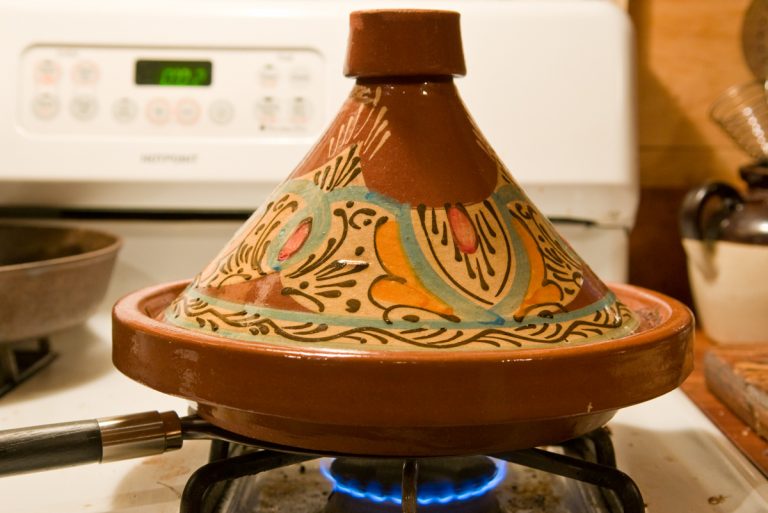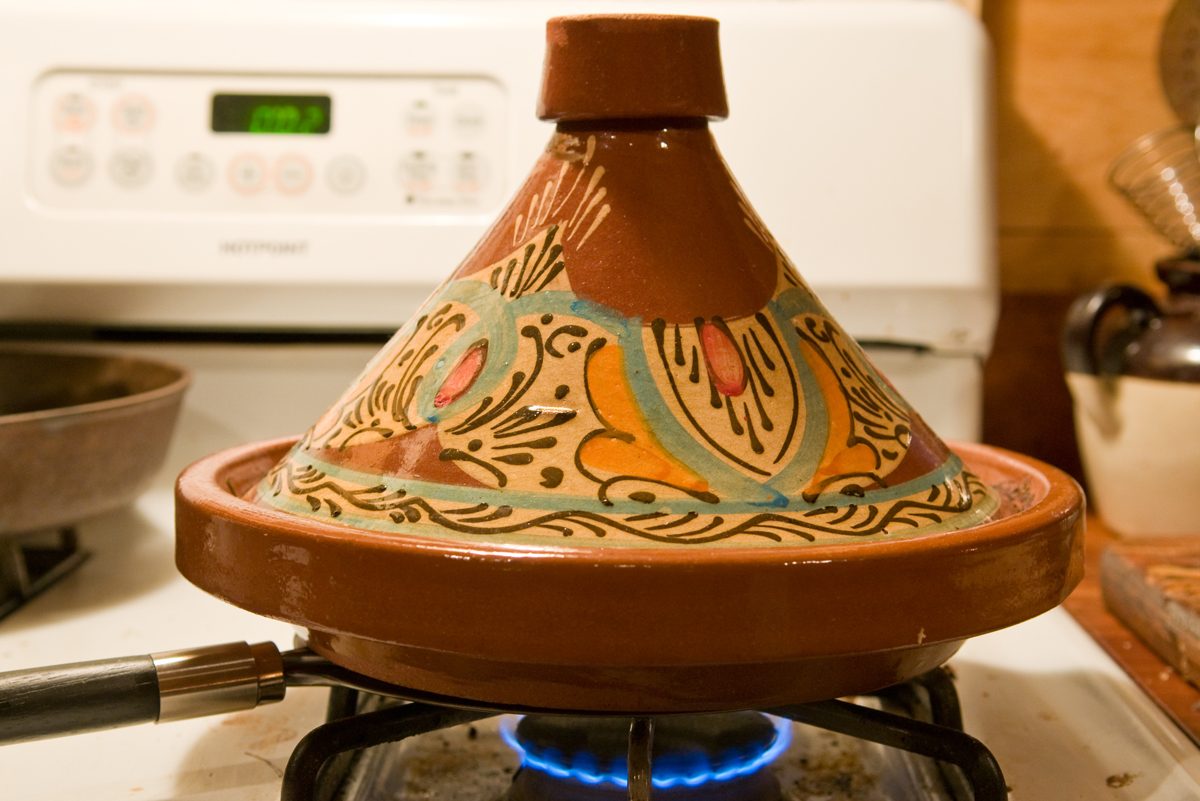 Tzimmes is a specialty of Ashkenazi Jews, while tajines come from Morocco. Although they have such different origins, these slow-cooked entrees share many qualities. Both make festive fare for Rosh Hashanah.
Tzimmes is a specialty of Ashkenazi Jews, while tajines come from Morocco. Although they have such different origins, these slow-cooked entrees share many qualities. Both make festive fare for Rosh Hashanah.
“Don’t make such a tzimmes out of it!” was my parents’ typical response to my childhood complaints when they meant not to make such a big deal. Undoubtedly this Ashkenazi expression was inspired by tzimmes in its most luxurious form–a casserole of meat, fruit, vegetables and even matzo balls.
Tzimmes figured frequently in our family’s Rosh Hashanah celebration, as it was the ideal dish to honor the custom of eating sweet foods to express the wish for a sweet year. In our home tzimmes was a luscious main course of beef stewed gently with carrots, sweet and white potatoes, prunes and brown sugar. Relatives, friends and neighbors of ours had tzimmes on their holiday tables too. Some kept theirs meatless and served it to accompany baked chicken or pot roast.
I discovered tajines years later, when Moroccan-Jewish friends in Paris introduced me to these aromatic entrees. They come in two basic types. Spicy tajines redolent of garlic, cumin and hot pepper are generally composed of meat and vegetables, although some variations are vegetarian or use fish like fresh sardines. Sweet tajines match meat with fruit. During my remaining years in Paris I eagerly sampled tajines at several couscous eateries. Upon moving to Los Angeles I prepared the fragrant stews at home, but when I missed those dining-out experiences, I was glad to find tajines at a few Moroccan restaurants.
What surprised me was how much the sweet tajines resembled my own tzimmes. Both feature meat cooked with dried fruit and honey in an onion-flavored broth. Neither one is sweet and sour. They contain no lemon juice, vinegar or other acidic ingredients, which some people avoid on Rosh Hashanah–another reason why both are perfect for the occasion.
Beef is the classic tzimmes favorite. Today many substitute chicken because it’s lower in fat. Humble versions of tzimmes consist simply of meat braised with sugar and one root vegetable but no fruit. Carrots and sweet potatoes are the most common, followed by white potatoes. Turnips might appear in the tzimmes pots of French Jews, and rutabaga in English ones.
Rosh Hashanah tzimmes is more festive–whether it’s meaty or meat-free, it often contains two or more vegetables as well as fruit. Prunes are by far the most traditional. For sweetening, honey is number one, with brown sugar a close second and white sugar considered OK too. Many season their tzimmes with only salt and pepper but I’m with those who add a pinch of cinnamon, nutmeg or cloves for extra zing. To make the hearty stew abundantly saucy, people simmer it with plenty of liquid and thicken the broth with a little flour. In the past the beef was browned in chicken fat but today vegetable oil is the routine replacement.
The main distinctions between tajines and tzimmes are in the flavorings, meats and vegetables. Sweet tajines always have spice, which beautifully balances their sweetness–usually saffron, cinnamon or both, often nutmeg and ginger as well, sometimes a touch of turmeric, but not the chiles and other pungent seasonings of the spicy tajines. Honey is the sweetener of choice and sugar is regarded merely as a substitute. Cooks thicken the tajine sauce by reduction, simmering it until the excess liquid evaporates and the taste is concentrated. If they brown the meat, they use olive or vegetable oil.
Lamb is the preferred protein for tajine, with beef somewhat less desirable. Chicken has long been nearly as popular in tajines as lamb. For these stews Moroccans share the Ashkenazi partiality for prunes but use raisins nearly as often. They also like dried apricots, dates, fresh quinces, apples and pears. A garnish of fried almonds or toasted sesame seeds provides a wonderful accent.
As for vegetables, in Moroccan kitchens they are ordinarily reserved for spicy tajines. Those who add vegetables to the sweet ones opt for one kind and either omit the fruit or use only raisins. The vegetable might be sweet potatoes or carrots, like in tzimmes, or occasionally pumpkin or tomatoes.
Tzimmes and tajines derive their delicious essences from their components and are made without stock or wine. How sweet to make them depends entirely on family tastes. My mother always sprinkled brown sugar with a light hand to subtly enhance her tzimmes. That’s how I love to sweeten both tzimmes and tajines.
In their native lands cooks came up with countless renditions of these homey dishes by taking advantage of local ingredients. That’s why North African tajines might have lamb and dates, while eastern European tzimmes has beef and carrots.
Neither recipe remains static. I’ve read of a tajine of seven vegetables poached with a sheep’s head but I haven’t heard of anyone who makes it now. We have a wealth of produce and fine meats available to embellish our New Year entrees. Prunes and apricots have become a popular pair in both stews for their complementary colors and tastes. French Moroccan Jews make tajines with veal, while Israelis and Californians sometimes prepare tzimmes with turkey and orange juice. Sometimes I add sweet New World vegetables like butternut squash, red bell peppers or corn. Still, I don’t tamper with these age-old favorites too much, particularly for the holidays, when the most important element of the menu is–tradition!
Have a Happy and Sweet Rosh Hashanah!
Faye Levy is the author of Healthy Cooking for the Jewish Home and 1,000 Jewish Recipes.
